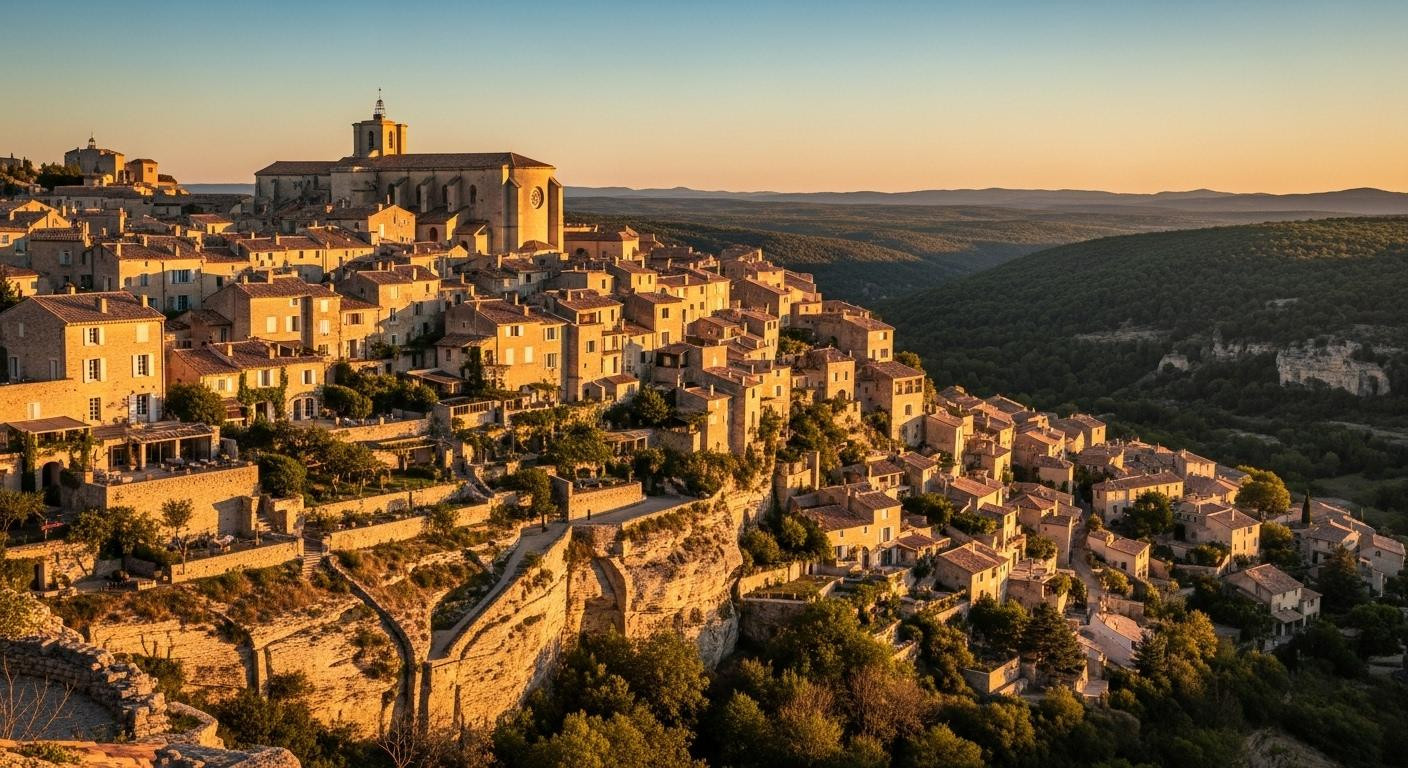At 5:47 PM on a November evening, honey-colored limestone begins its daily transformation in Gordes. What starts as pale morning stone deepens to amber as low-angle sunlight activates mineral deposits in ancient walls. While 1,664 permanent residents prepare dinner, the village literally glows gold above the Luberon valley. This isn’t tourist marketing. It’s geological fact meeting medieval architecture in France’s most photographed hill town.
Where 1,664 residents guard Provence’s golden hour village
Gordes perches at 1,115 feet on the Vaucluse Plateau’s rocky escarpment, 53 miles from Marseille Provence Airport. The village occupies defensive terrain inhabited since Neolithic times. Terraced architecture integrates naturally into cliffsides overlooking the Luberon valley.
Unlike Roussillon’s commercialized ochre or Saint-Paul-de-Vence’s tourist sprawl, Gordes maintains authenticity through membership in Les Plus Beaux Villages de France. This designation enforces strict architectural codes protecting honey-colored limestone facades. The D15 and D109 roads wind steeply into limited village parking, naturally controlling daily visitor flow.
Recent population data shows 1,664 permanent residents as of 2022, down from 1,974 in 2015. The same families steward these stone homes for generations. They open bakeries at 6:30 AM and maintain Tuesday markets that predate tourist calendars. Similar preservation efforts protect medieval streets across Europe, but few match Gordes’ dramatic clifftop setting.
Why limestone turns gold when most tourists leave
The 45-minute transformation nobody sees at noon
Between 5:30 PM and 6:15 PM November through March, low-angle sunlight activates iron oxides in Gordes’ honey-gold limestone. The chemical reaction transforms beige stone into amber, then deep gold, then rust-orange before twilight. Tour buses depart by 4 PM, missing the transformation entirely.
The phenomenon peaks during golden hour when shadows deepen cobblestone streets. Red-tiled roofs create contrast against warm stone. Photographers cluster at western overlooks, but locals watch from private terraces, sipping pastis while their village literally glows.
Medieval architecture that defies gravity
Terraced stone homes cling to cliffs at impossible angles, buttressed by neighbors in organic medieval engineering. The 11th-century Château de Gordes anchors the summit. Its Renaissance restoration preserves defensive walls that once repelled invasions.
Unlike Tuscan hill towns with wide piazzas, Gordes’ narrow streets and covered passageways create intimate scale. Every facade faces specific cardinal directions to maximize morning light and minimize mistral winds. This represents medieval climate design still functional after 900 years.
What visitors do and what locals protect
The Tuesday morning ritual tourists sleep through
At 7 AM Tuesdays, Gordes’ weekly market unfolds in Place du Château before tour buses arrive. Locals negotiate for Cavaillon melons, Apt candied fruits, and Banon goat cheese wrapped in chestnut leaves. This isn’t performance. It’s provisioning, the same ritual since medieval trade routes.
Vendors recognize regulars and speak rapid Provençal dialect. They pack purchases in reusable baskets. By 10 AM, tourist crowds arrive for Instagram photos, missing the authentic exchange entirely. Other European villages face similar challenges balancing tourism with local life.
Where lavender fields meet stone masonry
2.5 miles north, Abbaye de Sénanque’s 12th-century Cistercian monastery sits among lavender fields blooming mid-June through July. The 6 AM visit reveals morning mist lifting from purple rows with no crowds for 90 minutes.
Back in Gordes, local artisans practice stone masonry in family workshops. They craft olive wood bowls and weave Provençal textiles using skills passed through generations, uninterrupted by tourism economics.
Why Gordes feels like Tuscany before the crowds
The comparison proves precise: terraced stone architecture, dramatic valley views, honey-colored facades, red-tiled roofs. But Gordes delivers what Montepulciano and San Gimignano lost. 1,664 residents still live medieval rhythms in stone homes occupied (not converted to vacation rentals).
Accommodation costs $130-$275 nightly versus Tuscany’s $220-$440. Most significantly, Gordes reveals its magic at sunset when tour groups depart. Golden stone belongs to residents and travelers who understand timing is everything. California alternatives offer similar village aesthetics without crossing the Atlantic.
Your questions about this stone village of 1,664 residents that glows gold every sunset in Provence answered
When should I visit to see the golden glow?
November through March offers optimal sunset light (5:30-6:15 PM) with 60% fewer tourists than summer. Spring (March-May) and fall (September-November) balance pleasant weather with manageable crowds. Arrive by 3 PM to explore before golden hour, staying until twilight ends at 7 PM winter, 9 PM summer. Tuesday mornings (7-10 AM) reveal authentic market culture before tour buses arrive.
How much does it cost versus other Provence villages?
Mid-range accommodations average $130-$275 nightly, running 15-20% above rural Provence averages but 30-40% below Côte d’Azur rates. Casual bistro meals cost $17-$38 per person, upscale dining $77 plus. Château de Gordes entry runs $5-$11. Weekly budgets total $880-$1,320 for two (lodging, meals, activities), comparable to lesser-known Luberon villages and half Monaco rates.
What makes Gordes different from Roussillon or Bonnieux?
Population stability distinguishes Gordes: 1,664 permanent residents maintain authentic village life versus seasonal tourist economies. Architectural protection through Les Plus Beaux Villages de France preserves medieval integrity. Visual phenomenon creates genuine golden-hour transformation, not marketing hype. Similar authentic experiences exist in wine regions where locals prioritize tradition over tourism revenue.
At 6:15 PM, the last sunlight leaves stone facades as amber fades to grey. A resident locks the boulangerie where her family has baked since 1947. Steam rises from evening coffee while twilight settles over the Luberon valley. Tomorrow, the stone will glow gold again.
